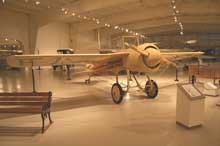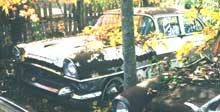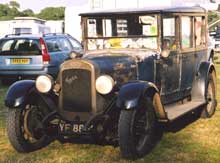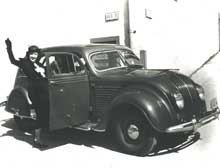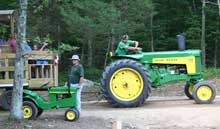As the Owl Flies
I'm suspicious of any museum with "transportation" in its name. Usually, either the mission is too broad or8-2 the museum is so large that the exhibits boggle the mind. A nice compromise is the Owls Head Transportation Museum in the Maine village of the same name.
Although the museum concerns transportation on water, rail and even space, it's mostly about automobiles and airplanes, with a few bicycles and motorbikes (and a sleigh) thrown in for balance. A common curse of auto museums is the tendency to put too many cars in too little space. The larger exhibit area required for airplanes all but eliminates this problem.
The charm of Owls Head is its eclecticism. In addition to the obligatory Duesenberg, Pierce-Arrow and Flying Lady-adorned Rolls-Royce, one finds a jaunty Léon Bollée tricar, massive Panhard touring car and rare Stevens-Duryea tourer, the latter once the property of artist Melbourne Brindle of Packard advertising renown. There's a nearly-complete collection of the works of James Scripps Booth, a Rocket cyclecar, Model C runabout and enigmatic Bi-Autogo. The designer of the Bi-Autogo, William B. Stout, is represented with his Stout Scarab, and there's the Eliot Cricket, an innovative automobile with aircraft-type controls. H.P Hood, the New England dairy, is present in the form of a Divco milk truck, and one can ask the man who owns one about his Rollson-bodied 1939 Packard. Next year will be the centenary of the Ford Model T, so Owls Head is preparing a T exhibit, including ane "ice T" for harvesting ice from Maine's many ponds.
You can't interpret manned flight in the United States without the Wright Brothers (theirs is a replica), but Owls Head is similarly diverse in its flight path. The magical Ornithopter is a mechanical bird, the Gazda Helicospeeder, an experimental craft from an Austrian-born inventor, and the Curtiss JN-4 "Jenny" (shown here with Jill) an icon of early American aviation. Of local interest is the Milliken M-1, a home-built craft that crashed on its maiden flight.
Before leaving, visitors should visit the Engine Room, where exhibits range from a giant Corliss steam powerplant to a tiny Locomobile steam engine and include internal combustion engines of inline automotive, radial aircraft and Wankel configuration.
Located two miles south of Rockland, Maine, the Owls Head Transportation Museum is open 361 days a year. Allow most of a day for a leisurely visit - finish up with a walk to the picturesque Owls Head lighthouse on the rock-bound coast. Or come for one of the museum's many special events. You'll have a great time.

